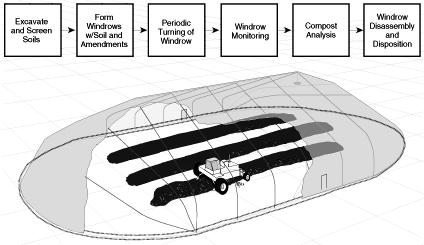Composting...
(Ex - Situ Soil Remediation Technology)...
Description...
Contaminated soil is excavated and mixed with bulking agents and organic amendments such as wood chips, hay, manure, and
vegetative (e.g., potato) wastes. Proper amendment selection ensure adequate porosity and provides a balance of carbon and
nitrogen to promote thermophilic, microbial activity. Composting is a controlled biological process by which organic
contaminants (e.g., PAHs) are converted by microorganisms (under aerobic and anaerobic conditions) to innocuous, stabilized
byproducts. Typically, thermophilic conditions (54 to 65 °C) must be maintained to properly compost soil contaminated with
hazardous organic contaminants. The increased temperatures result from heat produced by microorganisms during the degradation
of the organic material in the waste. In most cases, this is achieved by the use of indigenous microorganisms. Soils are
excavated and mixed with bulking agents and organic amendments, such as wood chips, animal, and vegetative wastes, to
enhance the porosity of the mixture to be decomposed. Maximum degradation efficiency is achieved through maintaining
oxygenation (e.g., daily windrow turning), irrigation as necessary, and closely monitoring moisture content, and temperature.
There are three process designs used in composting: aerated static pile composting (compost is formed into piles and aerated
with blowers or vacuum pumps), mechanically agitated in-vessel composting (compost is placed in a reactor vessel where it
is mixed and aerated), and windrow composting (compost is placed in long piles known as windrows and periodically mixed with
mobile equipment). Windrow composting is usually considered to be the most cost-effective composting alternative. Meanwhile,
it may also have the highest fugitive emissions. If VOC or SVOC contaminants are present in soils, off-gas control may be
required.

Applicability and Limitations...
The composting process may be applied to soils and lagoon sediments contaminated with biodegradable organic compounds. Pilot
and full-scale projects have demonstrated that aerobic, thermophilic composting is able to reduce the concentration of
explosives (TNT, RDX, and HMX), ammonium picrate (or yellow-D), and associated toxicity to acceptable levels. Aerobic,
thermophilic composting is also applicable to PAH-contaminated soil. All materials and equipment used for composting are
commercially available. The following factors may limit the applicability and effectiveness of the process ;
- Substantial space is required for composting.
- Excavation of contaminated soils is required and may cause the uncontrolled release of VOCs.
- Composting results in a volumetric increase in material because of the addition of amendment material.
- Although levels of metals may be reduced via dilution, heavy metals are not treated by
this method. Also high levels of heavy metals can be toxic to the microorganisms.
Performance Data...
Windrow composting has been demonstrated as an effective technology for treatment of explosives-contaminated soil. During a
field demonstration conducted by USAEC and the Umatilla Depot Activity (UMDA), TNT reductions were as high as 99.7% in 40
days of operation, with the majority of removal occurring in the first 20 days of operation. Maximum removal efficiencies
for RDX and HMX were 99.8% and 96.8%, respectively. The relatively simple equipment requirements combined with these performance
results make windrow composting economically and technically attractive.
Costs...
Costs will vary with the amount of soil to be treated, the soil fraction in the compost, availability of amendments, the
type of contaminant, and the type of process design employed. Estimated costs for full-scale windrow composting of
explosives - contaminated soils are approximately $190 per cubic yard for soil volumes of approximately 20,000 yd3.
Estimated costs for static pile composting and mechanically agitated in vessel composting are $236 and $290, respectively.
Composting may be an economic alternative to thermal treatment, however, when cleanup criteria and regulatory requirements
are suitable.



